
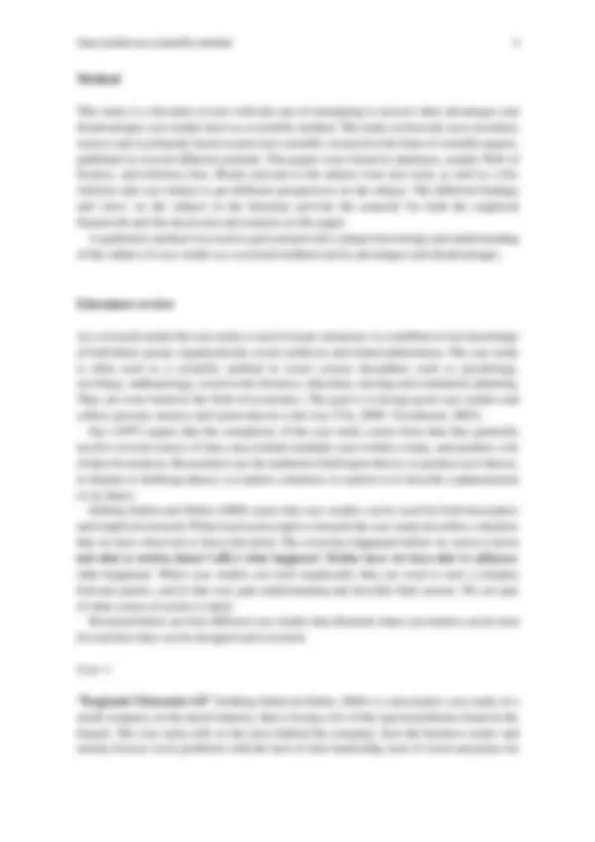
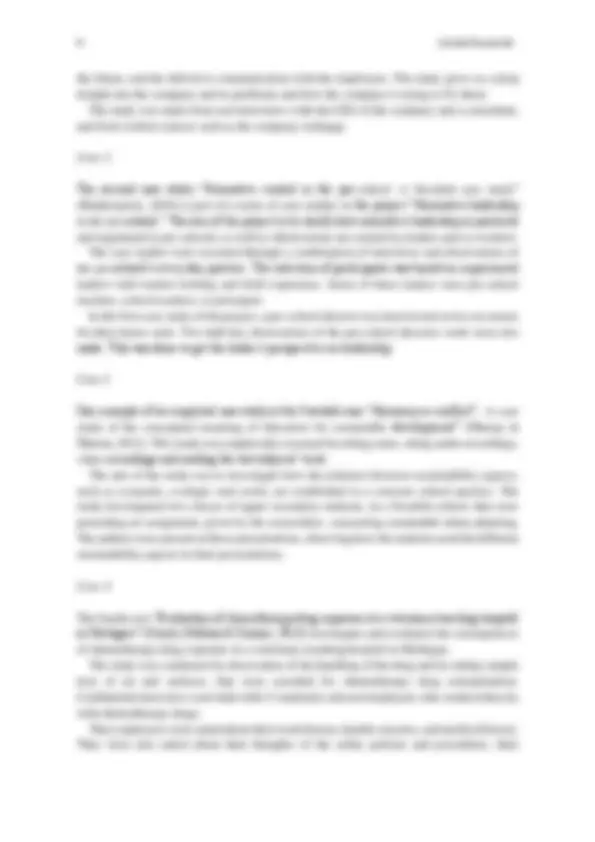
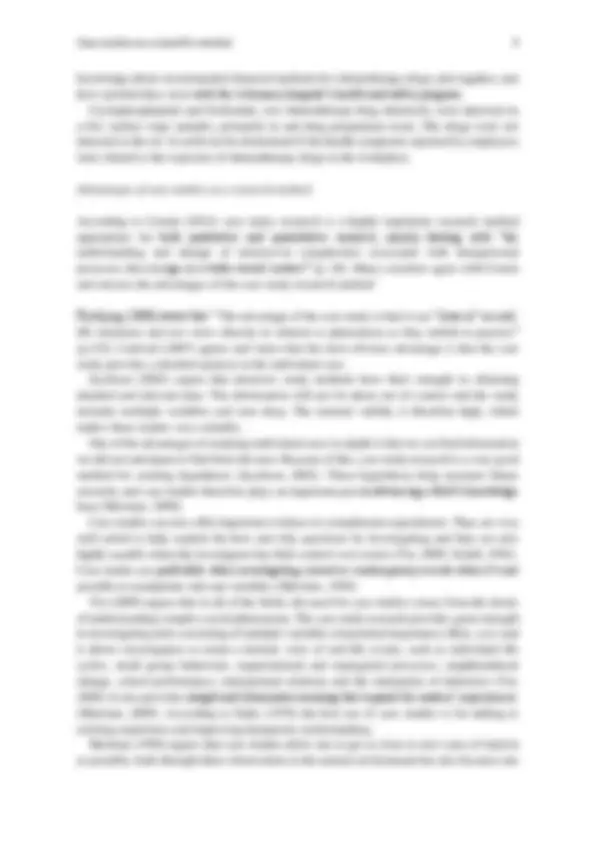
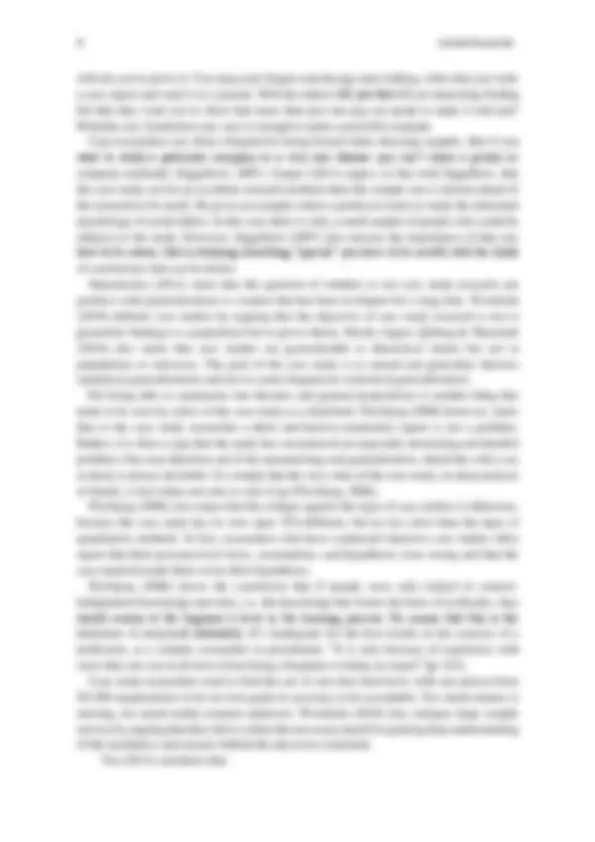
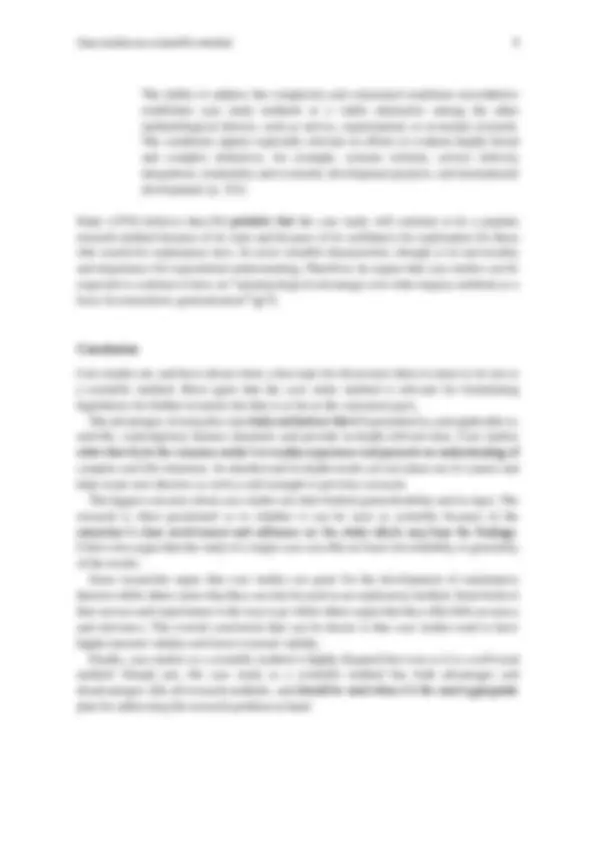
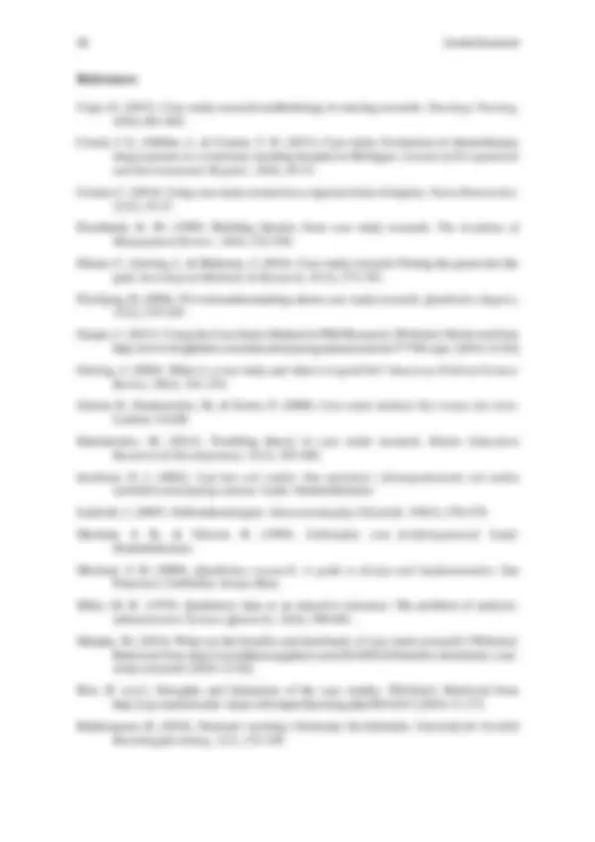


Study with the several resources on Docsity

Earn points by helping other students or get them with a premium plan


Prepare for your exams
Study with the several resources on Docsity

Earn points to download
Earn points by helping other students or get them with a premium plan
Community
Ask the community for help and clear up your study doubts
Discover the best universities in your country according to Docsity users
Free resources
Download our free guides on studying techniques, anxiety management strategies, and thesis advice from Docsity tutors
This literature review explores the advantages and disadvantages of using case studies as a scientific method, particularly in social science research. Case studies are defined as in-depth studies of specific units with multiple variables, providing valuable insights into complex social phenomena. Despite criticism regarding their lack of generalizability and scientific rigor, case studies continue to be widely used and respected in various fields.
What you will learn
Typology: Summaries
Uploaded on 09/12/2022
1 / 11

This page cannot be seen from the preview
Don't miss anything!







Linnéa Krusenvik Halmstad University, Halmstad, Sweden Abstract: The case study as a scientific method is, and has been for a long time, a subject of heavy discussion in the scientific community. Some scientists disregard the study completely and argue that it’s nothing more than story-telling, while others claim that the case study is the most relevant research method there is. As with all scientific methods case studies have both advantages and disadvantages and the aim of this study is to present and discuss these. Keywords: case studies; scientific method; qualitative; in-depth
Cope (2015) states that case study research is often described as a flexible but challenging methodology that is most commonly used in social science research. Of all the social science research methods the case study has the least attention and support, due to its lack of well- defined protocol. Lindvall (2007) argues that the methodological criticism directed towards case studies is also based on that the study cannot provide insights into causality and general conditions. Even though the study is heavily criticized, the method has never lacked advocates and a vast number of case studies are executed and published annually in scientific journals. Case studies are said to be an intensive study, which is defined as an in-depth study of few units with multiple variables. The purpose of intensive studies is to get as complete a picture as possible of a situation, a phenomenon or event (Jacobsen, 2002). In case studies, the focus is on one particular unit. These units can be of different kinds and they can be defined by both space and time. A unit can be an individual, a group, an organization or a local community. The use of case studies is suitable when we want to understand the interaction between a specific context and a phenomenon (Jacobsen, 2002). When it comes to the definition of a case study there are a few different suggestions. A well-known and used definition comes from Yin (2009) who defines the case study research method as: An empirical inquiry that investigates a contemporary phenomenon in depth and within its real-life context, especially when the boundaries between phenomenon and context are not clearly evident (p.18). Woodside (2010) uses a broader definition:
2 Linnéa Krusenvik Case study research is an inquiry that focuses on describing, understanding, predicting and/or controlling the individual (p.1). Gerring (2004) argues that, even though, much of what we know about the empirical world comes from case studies and the fact that a large number of scientific work is generated by case studies, the method is held in low regard. Verschuren (2003) means that one explanation for this is that the status of the case study as a research method is not quite clear. Even though case studies are common, there is a lack of clarity and no real consensus in what a case study is about, how to concretely conduct that form of research and what results can be obtained from it (Merriam, 1994). Gerring (2004) states that even many of the study’s defenders are confused when it comes to the strengths and weaknesses of this ambiguous research method. He says that: “The case study survives in a curious methodological limbo” (p.341). Another explanation of this unclear status is that the case study is often defined as the study of one single case, rather than as a way of doing research (Verschuren, 2003). Yin (2009) however, stresses that case studies have both advantages and disadvantages as a research method, and that it is important to understand and acknowledge that fact. Case study research, like all other research, complements the strengths and limitations of other types of research. Merriam (1994) agrees and mean that a researcher can choose from several different scientific approaches, that have their own way of illustrating something special about the phenomenon being studied. Whether or not to choose a case study or some other approach depends on what it is that the researcher is looking for and what questions the researcher wants to answer. Reis (n.d.) says that the merits of a particular method depend on if it’s the most appropriate way of addressing the research problem that we are facing. Background Historically, case study research was marked by periods of use and disuse (Cronin, 2014). In the beginning of the 20th^ century the university of Columbia in the USA, started to criticize the usage of case studies. They argued that case studies were too descriptive and qualitative to be able to contribute to the scientific research and dismissed the results and findings as lacking validity and reliability (Solberg Søilen & Huber, 2009; Elman, Gerring & Mahoney, 2007). The criticism received a lot of assent and the method was used to little extent, held in low regard or simply ignored, for many years (Solberg Søilen & Huber, 2009). According to Merriam (2009) it wasn’t until the evolution of qualitative research methods, in the 1980’s, that case studies received attention from a methodological perspective. Elman, Gerring and Mahoney (2016) and Merriam (2009) all argue that today the case study has gained a multitude of followers even though many scientists are still sceptical as to whether the study can be said to be of scientific value. The study is mainly viewed and used as a qualitative research method, even though it can also include quantitative analysis and historical data. Like all qualitative research the case study searches for meaning and understanding.
4 Linnéa Krusenvik the future, and the defective communication with the employees. The study gives us a deep insight into the company and its problems and how the company is trying to fix them. The study was made from oral interviews with the CEO of the company and a consultant, and from written sources such as the company webpage. Case 2. The second case study “Normative control in the pre-school: A Swedish case study” (Riddersporre, 2010) is part of a series of case studies in the project “Normative leadership in the pre-school.” The aim of the project is to clarify how normative leadership is practiced and negotiated in pre-schools, as well as which norms are created by leaders and co-workers. The case studies were executed through a combination of interviews and observations of the pre-school’s every day practice. The selection of participants was based on experienced leaders with teacher training and field experience. Some of these leaders were pre-school teachers, school teachers, or principals. In this first case study of the project, a pre-school director was interviewed at two occasions for three hours each. Two half-day observations of the pre-school directors work were also made. This was done to get the leader’s perspective on leadership. Case 3. One example of an empirical case study is the Swedish case “Harmony or conflict? - A case study of the conceptual meaning of education for sustainable development” (Öhman & Öhman, 2012). This study was empirically executed by taking notes, doing audio-recordings, video-recordings and reading the test subjects’ texts. The aim of the study was to investigate how the relations between sustainability aspects, such as economic, ecologic and social, are established in a concrete school practice. The study investigated two classes of upper secondary students, in a Swedish school, that were presenting an assignment, given by the researchers, concerning sustainable urban planning. The authors were present at these presentations, observing how the students used the different sustainability aspects in their presentations. Case 4. The fourth case “Evaluation of chemotherapy drug exposure at a veterinary teaching hospital in Michigan” (Couch, Gibbins & Connor, 2013) investigates and evaluates the consequences of chemotherapy drug exposure in a veterinary teaching hospital in Michigan. The study was conducted by observation of the handling of the drug and by taking sample tests of air and surfaces, that were searched for chemotherapy drug contamination. Confidential interviews were held with 13 randomly selected employees who worked directly with chemotherapy drugs. They employees were asked about their work history, health concerns, and medical history. They were also asked about their thoughts of the safety policies and procedures, their
Case studies as a scientific method 5 knowledge about recommended disposal methods for chemotherapy drugs and supplies, and how satisfied they were with the veterinary hospital’s health and safety program. Cyclophosphamide and ifosfamide, two chemotherapy drug chemicals, were detected on a few surface wipe samples, primarily in and drug preparation room. The drugs were not detected in the air. It could not be determined if the health symptoms reported by employees were related to the exposure of chemotherapy drugs in the workplace. Advantages of case studies as a research method According to Cronin (2014) case study research is a highly legitimate research method appropriate for both qualitative and quantitative research, mainly dealing with “the understanding and change of interwoven complexities associated with interpersonal processes that emerge in a wider social context” (p. 20). Many scientists agree with Cronin and stresses the advantages of the case study research method: Flyvbjerg (2006) states that: “The advantage of the case study is that it can “close in” on real- life situations and test views directly in relation to phenomena as they unfold in practice” (p.235). Lindvall (2007) agrees and states that the most obvious advantage is that the case study provides a detailed analysis in the individual case. Jacobsen (2002) argues that intensive study methods have their strength in obtaining detailed and relevant data. The information will not be taken out of context and the study includes multiple variables and runs deep. The internal validity is therefore high, which makes these studies very valuable. One of the advantages of studying individual cases in-depth is that we can find information we did not anticipate to find from the start. Because of this, case study research is a very good method for creating hypotheses (Jacobsen, 2002). These hypotheses help structure future research, and case studies therefore plays an important part in advancing a field’s knowledge base (Merriam, 2009). Case studies can also offer important evidence to complement experiments. They are very well suited to help explain the how and why questions by investigating and they are also highly useable when the investigator has little control over events (Yin, 2009; Schell, 1992). Case studies are preferable when investigating current or contemporary events when it’s not possible to manipulate relevant variables (Merriam, 1994). Yin (2009) argues that in all of the fields, the need for case studies comes from the desire of understanding complex social phenomena. The case study research provides great strength in investigating units consisting of multiple variables of potential importance (Reis, n.d.) and it allows investigators to retain a holistic view of real-life events, such as individual life cycles, small group behaviour, organizational and managerial processes, neighbourhood change, school performance, international relations and the maturation of industries (Yin, 2009). It also provides insight and illuminates meaning that expand the readers’ experiences. (Merriam, 2009). According to Stake ( 1978 ) the best use of case studies is for adding to existing experience and improving humanistic understanding. Merriam (1994) argues that case studies allow one to get as close to one's area of interest as possible, both through direct observation in the natural environment but also because one
Case studies as a scientific method 7 Few would think to question the relevance of the case study as a basis for creating hypotheses for further research, but quite a few would argue that research based on case studies is unlikely to be anything more than story-telling (Schell, 1992). Critics of case study research believe that the study’s usefulness is limited to, and only appropriate for, the exploratory phase of an investigation and that experiments are the only justified way of doing explanatory and casual inquiries. Case studies are seen as only a preliminary research method and cannot be used to describe or test propositions (Yin, 2009) Miles (1979) argues that the process of analysis during case-writing is intuitive, primitive and unmanageable in any rational sense which lead to unreliable and invalid conclusions. These invalid conclusions also stem from the fact that people participating in a case study often feel that they are not anonym and therefore give self-protective responses and self- aggrandizing responses that are not true. Miles (1979) also critique case research because collecting and analysing the data is a highly labour-intensive activity, often causing much stress, even for skilled research staff. Merriam (2009) agree that although rich, thick description and analysis of a phenomenon may be desired, a researcher may not have the time or money to devote to such an undertaking. Usually the studies take a long time to execute (Yin, 2009) and the product may be too lengthy, too detailed, or too involved for busy policymakers and practitioners to read and use (Merriam, 2009). The greatest concern with the case study, according to Yin (2009), is its lack of rigor. Yin (2009) means that all too often the case study investigator has so much freedom that he becomes sloppy and does not follow the systematic procedures, or allows dubious evidence or biased views to influence the directions of the findings and conclusions. He states that this lack of rigor is less likely to be present when using other methods because of the existence of numerous methodological texts providing investigators with specific procedures to be followed, which is limited in the case study method. The researcher’s independence from the results of the case study is often questioned, because in some types of case studies the researcher plays an interactive role instead of acting at a distance. Garger (2013) means that the researcher essentially becomes a part of the research itself and, knowing the expected results, the researcher may subconsciously guide the subjects towards those results, thereby confirming the expected results. This is what is known as the self-fulfilling prophecy and this is why the study becomes of doubtful scientific value (Flyvbjerg, 2006).
Even though the case study as a research method is faced with a lot of criticism and disadvantages, researchers continue to use the case study research method with success in carefully planned studies of real-life situations, issues, and problems (Soy, 1997). Some researcher argue that the disadvantages are not, in fact, always entitled: According to Siggelkow (2007) a small sample doesn’t have to be something negative. He uses an example to explain it: If you walk into my house with a pig and tells me it can talk; I
8 Linnéa Krusenvik will ask you to prove it. You snap your fingers and the pig starts talking. After that you write a case report and send it to a journal. Will the editors tell you that it’s an interesting finding but that they want you to show that more than just one pig can speak to make it relevant? Probably not. Sometimes one case is enough to make a powerful example. Case researchers are often critiqued for being biased when choosing samples. But if you want to study a particular company or a very rare disease you can’t chose a person or company randomly (Siggelkow, 2007). Garger (2013) argues, in line with Siggelkow, that the case study can be an excellent research method when the sample size is known ahead of the research to be small. He gives an example where a professor wants to study the abnormal psychology of serial killers. In this case there is only a small sample of people who could be subjects to the study. However, Siggelkow (2007) also stresses the importance of that you have to be aware, that in studying something “special” you have to be careful with the kinds of conclusions that can be drawn. Hammersley (2012) states that the question of whether or not case study research can produce valid generalizations is a matter that has been in dispute for a long time. Woodside (2010) defends case studies by arguing that the objective of case study research is not to generalize findings to a population but to prove theory. Ritzén, Sagen, Sjöberg & Thunstedt (2016) also claim that case studies are generalizable to theoretical claims but not to populations or universes. The goal of the case study is to extend and generalize theories (analytical generalization) and not to count frequencies (statistical generalization). Not being able to summarize into theories and general propositions is another thing that tends to be seen by critics of the case study as a drawback. Flyvbjerg (2006) however, states that to the case study researcher a thick and hard-to-summarize report is not a problem. Rather, it is often a sign that the study has encountered an especially interesting and detailed problem. One may therefore ask if the summarizing and generalization, which the critics see as ideal, is always desirable. It is simply that the very value of the case study, its deep analysis of details, is lost when one tries to sum it up (Flyvbjerg, 2006). Flyvbjerg (2006) also states that the critique against the rigor of case studies is fallacious, because the case study has its own rigor. It’s different, but no less strict than the rigor of quantitative methods. In fact, researchers who have conducted intensive case studies often report that their preconceived views, assumptions, and hypotheses were wrong and that the case material made them revise their hypotheses. Flyvbjerg (2006) draws the conclusion that if people were only trained in context- independent knowledge and rules, i.e. the knowledge that forms the basis of textbooks, they would remain at the beginner’s level in the learning process. He means that this is the limitation of analytical rationality: it’s inadequate for the best results in the exercise of a profession, as a student, researcher or practitioner. “It is only because of experience with cases that one can at all move from being a beginner to being an expert” (p. 222). Case study researchers tend to find the use of one-shot interviews with one person from 50 - 300 organizations to be too low-grade in accuracy to be acceptable. Too much nuance is missing, too much reality remains unknown. Woodside (2010) also critiques large sample surveys by arguing that they fail to collect the necessary detail for gaining deep understanding of the mechanics and reasons behind the processes examined. Yin (2013) concludes that:
10 Linnéa Krusenvik
Cope, D. (2015). Case study research methodology in nursing research. Oncology Nursing, 42 (6), 681-882. Couch, J. G., Gibbins, J., & Connor, T. H. (2013). Case study: Evaluation of chemotherapy drug exposure at a veterinary teaching hospital in Michigan. Journal of Occupational and Environmental Hygiene, 10 (4), 45-51. Cronin, C. (2014). Using case study research as a rigorous form of inquiry. Nurse Researcher, 21 (5), 19-27. Eisenhardt, K. M. (1989). Building theories from case study research. The Academy of Management Review, 14 (4), 532-550. Elman, C., Gerring, J., & Mahoney, J. (2016). Case study research: Putting the quant into the qual. Sociological Methods & Research, 45 (3), 375-391. Flyvbjerg, B. (2006). Five misunderstandings about case-study research. Qualitative Inquiry, 12 (2), 219-245. Garger, J. (2013). Using the Case Study Method in PhD Research. [Website]. Retrieved from http://www.brighthub.com/education/postgraduate/articles/77789.aspx [2016- 12 - 02] Gerring, J. (2004). What is a case study and what is it good for? American Political Science Review, 98 (2), 341-354. Gomm, R., Hammersley, M., & Foster, P. (2000). Case study method: Key issues, key texts. London: SAGE. Hammersley, M. (2012). Troubling theory in case study research. Higher Education Research & Developement, 31 (3), 393-405. Jacobsen, D. I. (2002). Vad hur och varför: Om metodval i företagsekonomi och andra samhällsvetenskapliga ämnen. Lund: Studentlitteratur. Lindvall, J. (2007). Fallstudiestrategier. Statsvetenskaplig Tidsskrift, 109 (3), 270-278. Merriam, S. B., & Nilsson, B. (1994). Fallstudien som forskningsmetod. Lund: Studentlitteratur. Merriam, S. B. (2009). Qualitative research: A guide to design and implementation. San Francisco, California: Jossey-Bass. Miles, M. B. (1979). Qualitative data as an attractive nuisance: The problem of analysis. Administrative Science Quarterly, 24 (4), 590-601. Murphy, M. (2014). What are the benefits and drawbacks of case study research? [Website]. Retrieved from http://socialtheoryapplied.com/2014/05/24/benefits-drawbacks-case- study-research/ [2016- 12 - 02] Reis, R. (n.d.). Strenghts and limitations of the case studies. [Website]. Retrieved from http://cgi.stanford.edu/~dept-ctl/tomprof/posting.php?ID=1013 [2016- 11 - 27] Riddersporre, B. (2010). Normativ styrning i förskolan: En fallstudie. Tidsskrift för Nordisk Barnehageforskning, 3 (3), 133-149.
Case studies as a scientific method 11 Ritzén, C., Sagen, F., Sjöberg, L., & Thunstedt, F. (2016). Fallstudier. Forskningsstrategier, [Blog]. Retrieved from https://forskningsstrategier.wordpress.com/fallstudier/ [2016- 11 - 17] Schell, C. (1992). The Value of the Case Study as a Research Strategy. Unpublished paper, Manchester Business School. Siggelkow, N. (2007). Persuasion with case studies. The Academy of Management Journal, 50 (1), 20-24. Solberg Søilen, K. & Huber, S. (2006). 20 svenska fallstudier för små och medelstora företag: Pedagogik och vetenskaplig metod. Lund: Studentlitteratur. Solberg Søilen, K. & Huber, S. (2004). Berglunds Mekaniska AB. Jönköping: Jönköping International Business School. Soy, S (1997). The case study as a research method. Unpublished paper, University of Texas at Austin. Stake, R. E. (1978). The case study method in social inquiry. Educational Researcher, 7 (2), 5 - 8. Verschuren, P. (2003). Case study as a research strategy: Some ambiguities and opportunities. International Journal of Social Research Methodology, 6 (2), 121-139. Woodside, A. G. (2010). Case study research: Theory, methods, practice. Bingley, UK: Emerald Group Pub. Ltd., ebrary Inc. Yin, R. K. (2009). Case study reserach: Design and methods. London: SAGE. Yin, R. K. (2013). Validity and generalization in future case study evaluations. Evaluation, 12 (1), 219-245. Öhman, M., & Öhman, J. (2012). Harmoni eller konflikt? - en fallstudie av meningsinnehållet i utbildning för hållbar utveckling. Nordina: Nordic Studies in Science Education, 8 (1), 59-72.